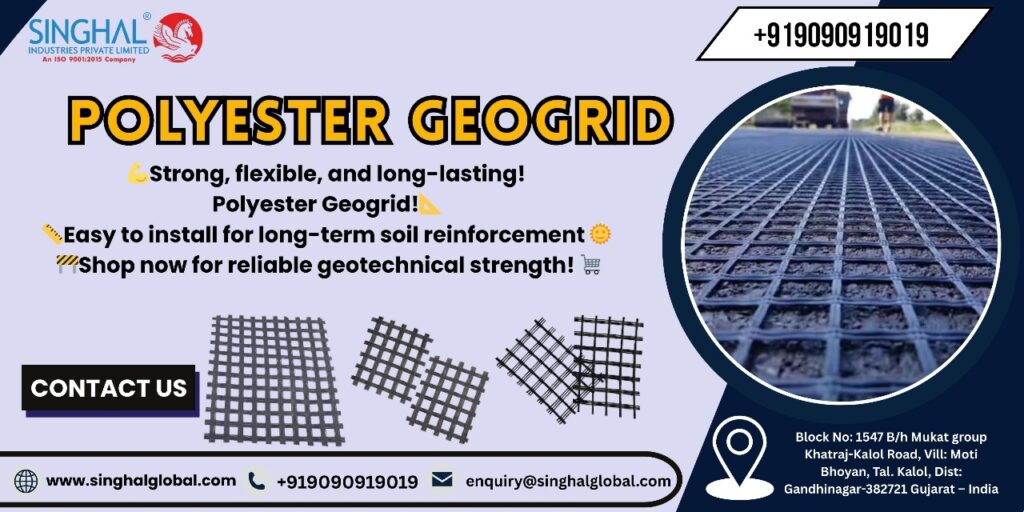In the case of constructing roads that can last over an extended period of time, engineers are now rapidly resorting to using new materials, which is both affordable and long lasting. Among these new innovations transforming the way infrastructure projects were handled is polyester geogrid. In a quiet revolution on how roads are strengthened, especially in areas where soil conditions must be hard to work on or traffic loads are immense, this flexible and yet strong material is gaining ground and reinventing the best ways roads can be strengthened. The needs of Polyester geogrid manufacturers are on the increase in India where the road infrastructure is continuously expanding not only because it is stronger but also because it is of long term gain.
What Is a Polyester Geogrid?
Geosynthetic Geo grids include a polyester geo grid which is a geo synthetic material constructed out of high tensile polyester yarns with some form of PVC or other protective coating completes. They (soil) are stabilized using these grids and are employed to reinforce the layers in a civil construction project. Its main strength is that the structure has an open-grid pattern, which allows the procedure of locking with soil or aggregate substances, thus increasing the capacity of the supporting surface.
They offer support, in other words, that cannot be viewed directly, but that most people will enjoy frequently as one drives on a high-quality road.
The Indian Perspective: A Growing Market
The use of Polyester geogrid India is increasingly becoming a common feature and with the growing development of the highways, expressways, rural roads and even the industrial corridors. Road bodies and even individual contractors are slowly coming to recognize the idea that such materials can dramatically decrease the need to undertake the road body maintenance and enhance general performance. The trend has led to growth in the need of quality polyester geogrid manufacturers who can supply different geogrid requirements in different project as well as international quality conformance.
Besides, polypropylene geogrids are currently competitive in polypropylene geogrid price and also the polyester substitutes can be attained locally; thus, no longer relying on imports.
Real-Life Example: Saving Roads in Monsoon-Prone Areas
The polyester geogrids have performed exceptionally well in states, such as Kerala, Maharashtra, and Assam -where rainfalls tend to interfere with the road subgrades remain. Roads constructed using geogrid layers have less potholing and rutting during the monsoons as the substructure is well stabilized by the consolidation of the subbase and because of the reduced differential settlement.
In one coastal Maharashtra municipal project, geogrid placed in one section of the road known to collapse every year was done with polyester geogrids by engineers. The villagers used to be stunned. One farmer stated that we used to lose access every monsoon. This time the road did not go away. Perhaps it is enchantment; perhaps it is this grid on which they worked.”
How Polyester Geogrid Works in Road Construction
Polyester geo grids are installed under the aggregate base or the asphalt layer:
- Reduce lateral aggregates motion.
- Stop cracking of asphalt overlays reflectively.
These functionalities directly have a positive effect on increasing the life of roads served and decreasing the cost of maintaining the roads, which is a big advantage both to the government agencies and tax payers.
Why Choose Polyester Over Other Geogrids?
The question that arises at this point is this: in the presence of polypropylene and fiberglass geogrids, why then polyester?
The explanation is the following characteristics:
- Greater tensile strength per weight than others.
- UV degradation resistance, resistance to biological attacks.
- Low cost throughout the life of the road.
Moreover, the Polypropylene geogrid price can appear attractive in the first place, however, when speaking about roads with long spans or critical traffic areas, the polyester will be worth the investment due to greater durability.
Sustainability: A Silent Advantage
Sustainability of infrastructure has become a responsibility rather than a buzzword in the contemporary world. Polyester geogrids help in terms of sustainability since they may prolong the life of a road, maintenance of the road road, had to some level they can reduce the amount of raw materials needed to be used in the construction of roads and also they can save fuel since it does not cause many delays as a result of road work.
They might not be biodegradable though, but using them straightly means less environmental effects on construction activity.
Conclusion
The backbone of any country is the roads. To invest in such materials as polyester geogrids is to invest in durability, strength and a decreased environmental footprint. In India, with its large terrains and extreme climates the road infrastructure has to adhere to the extreme conditions presented by the environment, this material is not of any value- it has to be used.
Thus, whether you are a contractor, governmental officer, or project advisor, assume that polyester geogrids belong to the design check list. There are numerous well-established manufacturers of polyester geogrids that will give you quality products at reasonable prices having noted that the polypropylene geogrid price has become competitive just like the advanced polyester geogrid products.
Frequently Asked Questions (FAQs)
Q.1 What are the main uses of Polyester Geogrids?
The main ways of polyester geogrids application are located on the roads construction, embankment, retaining walls, rail subgrades and landfills. They are highly useful in an application where high tensile strength and soil stabilization requirement is required. This can be said of the fact that they are adaptable to both soft soil reinforcements and steep slopes stabilizations.
Q.2 What are the standard sizes and roll lengths?
The industry standard polyester geogrid is available in a 1 m to 4m wide and a 50 m to 200 m length. Nonetheless, customization is a frequent option on the part of the leading polyester geogrid manufactures in India depending upon the magnitude and needs of the project. Before any procurement always ensure that you get what size and strength grade of the mesh you want is required.
Q.3 What is the typical tensile strength of Polyester Geogrid?
The tensile strength depends on the use. Common grades are available with tensile strength in the range 20 kN/m to 300 kN/m. The tensile strength to be adopted is normally selected by the engineers depending on the anticipated traffic, soil condition, and other formulation necessities.
Q.4 How is Polyester Geogrid manufactured?
Polyester geogrids are produced by weaving high tenacity polyester yarns and then coated with some kind of protecting materials, such as PVC. The woolen yarns are glossed up and UV resistant and then stitched or knitted up into a grid like pattern. Manufacturers of polyester geogrid roll and test the final product after which it is shipped out.









